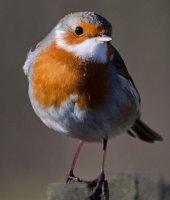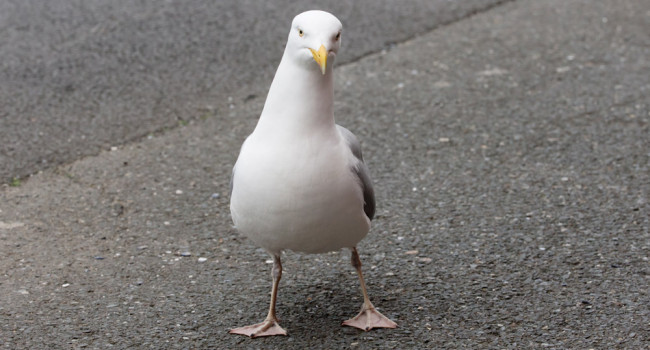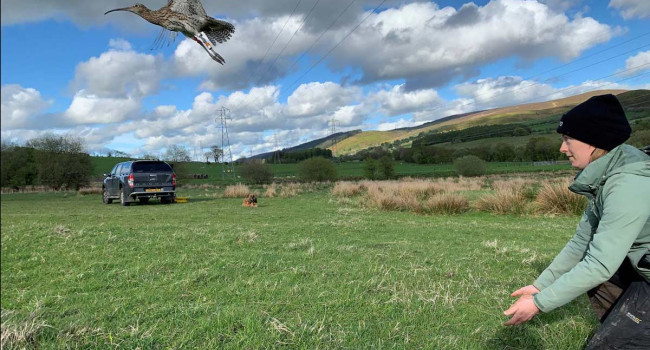What's red, brown and white all over?
01 Dec 2012 | No. 2012-49
Santa Robin! This remarkable bird has been spotted through the British Trust for Ornithology’s (BTO) Abnormal Plumage Survey. The charity is calling for more householders to look out for strange-looking birds in their gardens this winter.
Not feeling Christmassy yet? A Robin with a Father Christmas ‘beard’ should do the job! ‘Santa Robin’, which has been seen by Ian Wilson in Derbyshire, has a condition known as leucism. This inherited disorder causes parts of a bird’s plumage not to have their normal colour and to appear white, often affecting areas around the face and on the wings.
It’s not just Robins that are being spotted through the BTO Abnormal Plumage Survey. In total, over 1,500 birds across more than 35 species – ranging from Blue Tit and Chaffinch to Buzzard and Coot – have already been recorded in the nation’s gardens. Blackbirds with unusual white feathers have been logged most often, with members of the crow family, including Jackdaw, Carrion Crow and Rook, also featuring highly.
Some of the more extraordinary sights have been black-headed Blue Tits, red-tinted House Sparrows and a Goldfinch with an orange instead of a red face. On some occasions, people have been so puzzled that they have had to write ‘species unknown’. There is much more to find out about birds with abnormal-coloured plumage and the BTO wants householders to share what they see.
Tim Harrison, BTO Abnormal Plumage Survey coordinator, commented: “The red breast of a Robin doesn’t just make it look pretty – it plays an important role in its life. Unlike most other garden birds, Robins defend their territories throughout the year and display using their breast to warn rivals to ‘keep out’. It is possible that a white ‘beard’ could affect this communication.”
Hein van Grouw, Curator at the Natural History Museum, added: “The most common form of leucism in birds only affects the body parts farthest away from the pigment cell’s origin in the embryonic spinal cord – i.e. the face, wingtips, feet and belly. This Robin shows a moderate form of the condition and so only the chin and a few outer flight feathers are affected.”
Tim concluded: “With the help of the public, the BTO Abnormal Plumage Survey is charting odd-looking garden birds up and down the country, with records extending from Shetland to the Scilly Isles. Please keep your eyes peeled and let the BTO know what strange birds you see.”
To take part in the Abnormal Plumage Survey, visit www.bto.org/gbw or telephone 01842-750050 for a paper recording form.
Notes for Editors
- BTO Abnormal Plumage Survey
Anecdotal reports have shown that birds can turn up in gardens with a variety of unusually-coloured feathers, but questions about which species are affected most frequently, in what ways and where these birds are found remain unsolved. The Abnormal Plumage Survey is gathering data to explore these questions. - The BTO is the UK's leading bird research organisation. Over thirty thousand birdwatchers contribute to the BTO's surveys. They collect information that forms the basis of conservation action in the UK. The BTO maintains a staff of 100 at its offices in Norfolk, Stirling and Bangor, who analyse and publicise the results of project work. The BTO's investigations are funded by members, government, industry and conservation organisations. www.bto.org
Contact Details
Tim Harrison
(BTO Abnormal Plumage Survey coordinator)
Office: 01842 750050
(9am to 5.30pm)
Email: tim.harrison [at] bto.org
Paul Stancliffe
(BTO Media Manager)
Office: 01842 750050
(9am to 5.30pm)
Mobile: 07585 440910 (anytime)
Email: press [at] bto.org
Images are available for use alongside this News Release
Please contact images [at] bto.org quoting reference 2012-49
The BTO has an ISDN line available for radio interviews.
Please contact us to book an interview
Office: 01842 750050








Share this page